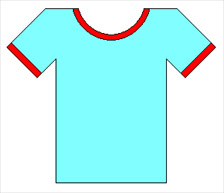T-shirt
T-shirt is a style of fabric shirt named after the T shape of its body and sleeves. Traditionally, it has short sleeves and a round neckline, known as a crew neck, which lacks a collar. T-shirts are generally made of a stretchy, light, and inexpensive fabric and are easy to clean.
History[edit | edit source]
The T-shirt evolved from undergarments used in the 19th century, initially cutting the one-piece "union suit" underwear into separate top and bottom garments, with the top long enough to tuck under the waistband of the bottoms. T-shirts, as a separate piece of clothing without buttons, were adopted by miners and stevedores during the late 19th century as a convenient covering for hot environments.
By the Great Depression, the T-shirt was often the default garment to be worn when doing farm or ranch chores, as well as other times when modesty called for a torso covering but conditions called for lightweight fabrics. A V-neck T-shirt has a V-shaped neckline, as opposed to the round neckline of the more common crew neck shirt.
T-shirts were also used as a medium for wearable art in the 1960s, with screen-printing becoming a popular method of decorating. The rise of online shopping in the early 21st century greatly increased the variety and availability of T-shirt designs.
Materials and Manufacture[edit | edit source]
The majority of modern T-shirts are made from cotton or a cotton blend. The fabric's quality can vary significantly, affecting its texture, durability, and ability to wick away moisture. High-quality T-shirts tend to be made from 100% cotton, particularly Pima or Egyptian cotton, known for their long fiber lengths, which result in a finer, softer, and more durable fabric. Some T-shirts are made from a blend of cotton and synthetic fibers, such as polyester, to reduce costs, improve durability, or achieve a specific texture.
The manufacturing process of T-shirts involves various steps, including spinning, knitting, dyeing, cutting, and sewing. The process may vary depending on the complexity of the design and the materials used. Screen printing is a common method for adding designs to T-shirts, involving creating a stencil (or "screen") and using it to apply layers of ink on the surface of the fabric.
Styles and Trends[edit | edit source]
T-shirts have evolved from undergarments to fashion statements, with various styles and trends over the years. They can range from simple, plain designs to elaborate graphics and messages. Some common styles include:
- Plain T-shirts: A single color that can be worn on its own or under other clothing. - Graphic T-shirts: Feature logos, slogans, artwork, or other designs. - Embroidered T-shirts: Have designs sewn into the fabric for a textured look. - Long-sleeved T-shirts: Offer more coverage and are suitable for cooler temperatures. - V-neck and scoop neck T-shirts: Provide alternatives to the traditional crew neck.
T-shirts are also used for promotional items, as they are relatively inexpensive to manufacture and can be widely distributed. They are popular for advertising, souvenirs, and merchandise for bands, brands, and events.
Cultural Impact[edit | edit source]
The T-shirt has had a significant cultural impact, serving as a medium for self-expression and individuality. It has been used to convey political messages, show support for bands and causes, and simply to display artistic designs. The T-shirt's simplicity and versatility have made it a staple in wardrobes around the world, transcending age, gender, and socioeconomic status.
Environmental Considerations[edit | edit source]
The production and disposal of T-shirts have environmental impacts, including water usage, chemical pollution, and textile waste. The fashion industry is working towards more sustainable practices, such as using organic cotton, recycling materials, and reducing water and energy consumption.
Search WikiMD
Ad.Tired of being Overweight? Try W8MD's physician weight loss program.
Semaglutide (Ozempic / Wegovy and Tirzepatide (Mounjaro / Zepbound) available.
Advertise on WikiMD
|
WikiMD's Wellness Encyclopedia |
| Let Food Be Thy Medicine Medicine Thy Food - Hippocrates |
Translate this page: - East Asian
中文,
日本,
한국어,
South Asian
हिन्दी,
தமிழ்,
తెలుగు,
Urdu,
ಕನ್ನಡ,
Southeast Asian
Indonesian,
Vietnamese,
Thai,
မြန်မာဘာသာ,
বাংলা
European
español,
Deutsch,
français,
Greek,
português do Brasil,
polski,
română,
русский,
Nederlands,
norsk,
svenska,
suomi,
Italian
Middle Eastern & African
عربى,
Turkish,
Persian,
Hebrew,
Afrikaans,
isiZulu,
Kiswahili,
Other
Bulgarian,
Hungarian,
Czech,
Swedish,
മലയാളം,
मराठी,
ਪੰਜਾਬੀ,
ગુજરાતી,
Portuguese,
Ukrainian
Medical Disclaimer: WikiMD is not a substitute for professional medical advice. The information on WikiMD is provided as an information resource only, may be incorrect, outdated or misleading, and is not to be used or relied on for any diagnostic or treatment purposes. Please consult your health care provider before making any healthcare decisions or for guidance about a specific medical condition. WikiMD expressly disclaims responsibility, and shall have no liability, for any damages, loss, injury, or liability whatsoever suffered as a result of your reliance on the information contained in this site. By visiting this site you agree to the foregoing terms and conditions, which may from time to time be changed or supplemented by WikiMD. If you do not agree to the foregoing terms and conditions, you should not enter or use this site. See full disclaimer.
Credits:Most images are courtesy of Wikimedia commons, and templates, categories Wikipedia, licensed under CC BY SA or similar.
Contributors: Prab R. Tumpati, MD





